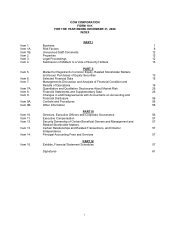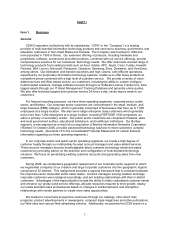CDW 2006 Annual Report Download - page 20
Download and view the complete annual report
Please find page 20 of the 2006 CDW annual report below. You can navigate through the pages in the report by either clicking on the pages listed below, or by using the keyword search tool below to find specific information within the annual report.10
• national direct marketers, such as Insight Enterprises, PC Connection, PC Mall and Zones;
• value-added resellers;
• manufacturers, such as Dell, Hewlett-Packard, and Apple, who sell directly to customers;
• computer superstores, such as CompUSA;
• government resellers, such as GTSI;
• software resellers, such as ASAP, Softchoice, and Software House International;
• consumer electronic and office supply superstores, such as Best Buy, Circuit City, Office
Depot, Office Max and Staples;
• corporate resellers;
• Web resellers, such as Amazon.com, Buy.com and Newegg.com;
• mass merchandisers, such as Wal-Mart and Costco; and
• managed service providers, such as IBM, Sungard, Vericenter, Verizon, AT&T, and EDS.
Some of our hardware and software vendors, such as Apple, Hewlett-Packard, IBM, and Lenovo,
have sold, and could intensify their efforts to sell, their products directly to customers. In addition,
some software manufacturers have developed, and may continue to develop, sales methods that
directly provide customers with subscription-based software programs and packages. If either of
these trends becomes more prevalent, it could adversely affect our sales growth and profitability.
We focus on offering a high level of service to gain new customers and retain existing customers.
While our value proposition to customers includes competitive pricing, pricing is only one aspect of
our ability to compete. However, competition may increase in the future, which could require us to
reduce prices, increase advertising expenditures or take other actions which may have an adverse
effect on our operating results. Some of our competitors have reduced their prices in an attempt to
stimulate sales. Decreasing prices of information technology products and accessories resulting from
competition and technological changes require us to sell a greater number of products to achieve the
same level of net sales and gross profit. If this trend continues and we are unable to attract new
customers and sell increased quantities of products, our sales growth and profitability could be
adversely affected.
We are exposed to inventory risks. We are exposed to inventory risks as a result of the rapid
technological changes that affect the market and pricing for the products we sell. We seek to
minimize our inventory exposure through a variety of inventory management procedures and policies,
including our rapid-turn inventory model, as well as vendor price protection and product return
programs. However, if we were unable to maintain our rapid-turn inventory model, if there were
unforeseen product developments that created more rapid obsolescence or if vendors were to
change their terms and conditions, our inventory risks could increase. We also periodically take
advantage of cost savings associated with certain opportunistic bulk inventory purchases offered by
our vendors. These bulk purchases could increase our exposure to inventory obsolescence.
Our future operating results may fluctuate significantly. We may experience significant variations
in our future quarterly results of operations. These fluctuations may result from many factors,
including the condition of the information technology industry in general, shifts in demand and pricing
for hardware and software products and the introduction of new products or upgrades. Our operating
results are also highly dependent on our level of gross profit as a percentage of net sales. Our gross
profit percentage fluctuates due to numerous factors, some of which may be outside of our control.
These factors include:
• our pricing strategies;
• changes in product costs from vendors;
• the availability of price protection, purchase discounts and incentive programs from vendors;
• the availability of cooperative advertising funds from vendors, which are classified as a
reduction of cost of sales;
• the risk of some of the items in our inventory becoming obsolete;
• the relative mix of products sold, and customers sold to, during the period;
























